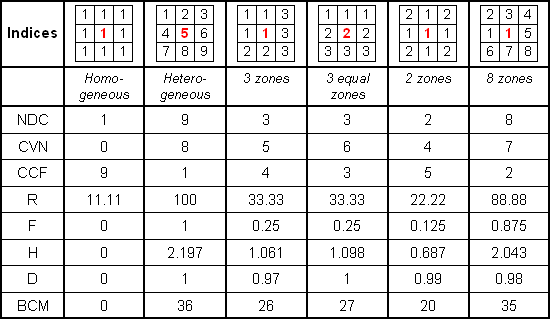Indices of variability
The variability of the values inside the neighborhood defined by the moving window can be expressed
by a variety of indices. The following indices will be retained:
|
| Index of heterogeneity (NDC),
nominal level: |
|
|
| c: number of different values, categories or classes present in the neighborhood |
Interpretation: It is a simple indication of diversityx
expressing the thematic richness
in the neighborhood.
It is equivalent to the index of richness (PR) applied to the objects in the study area.
|
|
|
| Index center-neighborhood (CVN),
nominal level: |
|
|
| nd: number of values different from the central cell value |
Interpretation: This index accounts for the insulation of the
central property compared to its neighborhood.
It expresses the degree of heterogeneity between the central cell and its neighborhood.
Its value is relative to the number of potential properties in the image.
|
|
|
| Index of frequency of the central class (CCF),
nominal level: |
|
|
| fc: frequency of the central cell value present in the neighborhood |
Interpretation: This index expresses the importance of the central value in the neighborhood.
Its value varies between 1 (insulation) and np, the number of cells of the neighborhood.
This maximum value characterizes a homogeneous neighborhood.
|
|
|
| Index of relative richness (R), nominal level: |
|
|
c: number of different values present in the neighborhood
cmax: number of different values present in the image
|
Interpretation: It is an indication of relative diversity compared to the whole of the values of the image.
It is expressed in % and varies from 100 for a maximum diversity with a value close to 0 (100/cmax)
for a homogeneous neighborhood.
|
|
|
| Index of fragmentation (F),
nominal level: |
|
|
c: number of different values present in the neighborhood
np: number of cells considered in the neighborhood (window)
|
Interpretation: It is an indication of diversity for the whole of the neighborhood.
It varies from 0 for a homogeneous neighborhood with 1 for a completely heterogeneous neighborhood.
|
|
|
| Index of diversity (H),
nominal level: |
|
|
Σ: sum of all the values present in the image
Pi: proportion of each value i in the neighborhood
ln: natural logarithm
|
Interpretation: The index H equals 0 when the neighborhood
is composed of only one value (thematic homogeneity).
Its value increases according to the number of properties (richness, diversity)
as well as to the tendency to the uniformity of the surfaces of each one of them.
It corresponds to the index of diversity of Shannon (SHDI) applied to the neighborhood.
|
|
|
| Index of predominance (D),
nominal level: |
|
|
Σ: sum of all the values present in the image
Pi: proportion of each value i in the neighborhood
ln: natural logarithm
c: number of different values present in the neighborhood
H: Index of diversity
Hmax: maximum diversity
|
Interpretation: The index D varies between 0 and 1.
Its value is equal to 0 when the neighborhood is composed of a single value (thematic homogeneity).
Its value approaches 0 when the frequencies of each value are very different (irregularity, predominance of value).
The index is equal to 1 when the frequencies are equal (regularity).
It corresponds to the index of regularity of Shannon (SHEI) applied to the neighborhood.
It is in fact a standardization of the index H.
|
|
|
| Index of different pairs (BCM), nominal level: |
|
|
| nPd: a number of pairs of different values in the neighborhood considered
|
Interpretation: It is an indication of diversity for the whole of the neighborhood.
It varies from 0 for a homogeneous neighborhood with a maximum value according to the importance of the neighborhood.
The pairs of cells whose value is not identical are counted.
All the pairs of cells of the neighborhood, even those noncontiguous, are considered.
|
|
|
Indices of variability applied to different local arrangements.
Value of the central cell of the window for the various indices.
The diversity of values present in the whole of the image
(cmax) is set to 9.
|
|
|
In conclusion, one notes that among these indices of variability each
one characterizes a particular aspect of the arrangement of the properties in
the neighborhood or then express this in a relative or absolute way. These indices
are particularly adapted to a nominal level of measurement because they consider
neither the hierarchy of the values nor their intervals.
Exercies on Table 3.6
- In the Table 3.6 which index gives best account of the differences
in arrangement for the 6 cases presented?
- order this choice according to performances of the indices.
- What is the influence of the values assigned to properties on
the value of each produced index?
- what can one conclude from it?
 Table 3.6
Table 3.6







